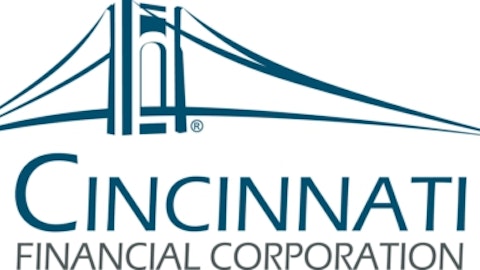Dividend Analysis
We analyze 25+ years of dividend data and 10+ years of fundamental data to understand the safety and growth prospects of a dividend. CINF’s long-term dividend and fundamental data charts can all be seen by clicking here.
Dividend Safety Score
Our Safety Score answers the question, “Is the current dividend payment safe?” We look at factors such as current and historical EPS and FCF payout ratios, debt levels, free cash flow generation, industry cyclicality, ROIC trends, and more. Scores of 50 are average, 75 or higher is very good, and 25 or lower is considered weak.
CINF’s dividend is safer than most company’s dividends with a Safety Score of 65. Over the last four quarters, CINF’s dividend has consumed 59% of its earnings and 39% of its free cash flow. These are reasonable payout ratios, but we wouldn’t want to see them move much higher given the risk of unexpected catastrophe events hitting profits like they did in 2011 (see below).

Source: Simply Safe Dividends

Source: Simply Safe Dividends
One of the things we like about insurance is that it is always in demand regardless of economic conditions. We can see that CINF’s sales fell by 10% during fiscal year 2008 but increased by 2% in 2009. The stock also outperformed the S&P 500 by 14% in 2008 and raised its dividend.
However, CINF’s investment portfolio (remember its above-average exposure to equities?) performed poorly and the company was hit with underwriting losses that caused earnings per share and free cash flow per share to drop by 47% and 26%, respectively, in fiscal year 2008. While CINF’s sales don’t fluctuate too much, its profits are clearly impacted during recessions.

Source: Simply Safe Dividends
Importantly, CINF’s business model generates solid free cash flow in any environment. Even during the depths of the financial crisis, CINF generated enough free cash flow per share ($2.74) to more than cover its current annual dividend payment ($1.84). However, the chart below also highlights the impact that record high catastrophe events can have on the business (see fiscal year 2011).

Source: Simply Safe Dividends
While the insurance industry has numerous attractive characteristics, it is still a commodity product. As seen below, CINF’s return on invested capital has remained positive but under 10% since fiscal year 2008. While the company is still creating value for shareholders, its return on capital will always be constrained by the industry’s dynamics.

Source: Simply Safe Dividends
Finally, CINF’s balance sheet is in great shape. The company’s debt to capital ratio is a conservative 12%, and it could cover its entire debt balance with cash on hand and less than half a year of earnings before interest and taxes. CINF also has strong credit ratings with S&P and Fitch. This is important given the unpredictable nature of catastrophe events in the insurance industry.



